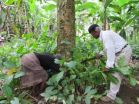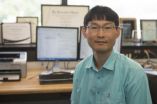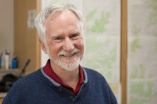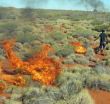(Press-News.org) LA JOLLA—For hundreds of years, healers in São Tomé e Príncipe—an island off the western coast of Africa—have prescribed cata-manginga leaves and bark to their patients. These pickings from the Voacanga africana tree are said to decrease inflammation and ease the symptoms of mental disorders.
Now, scientists at the Salk Institute for Biological Studies have discovered that the power of the plant isn't just folklore: a compound isolated from Voacanga africana protects cells from altered molecular pathways linked to Alzheimer's disease, Parkinson's disease and the neurodegeneration that often follows a stroke.
"What this provides us with is a source of potential new drug targets," says senior author Pamela Maher, a senior staff scientist in Salk's Cellular Neurobiology Laboratory. The results were published this week in the Journal of Ethnopharmacology.
Antonio Currais, a research associate who works with Maher, was visiting family in his native Portugal when he crossed paths with Maria do Céu Madureira, an ethnopharmacology researcher at the University of Coimbra. For the past twenty years, Madureira has been surveying the use of herbal medicine on the island. Currais and Maher had recently developed a series of tests to screen compounds for their potential use in treating neurodegenerative disorders and Currais saw the perfect chance to put the assay to the test. He began a collaboration with Madureira's team.
"There was already a lot of descriptive information of particular plants that have potential effects on the nervous system," Currais says. "We took that further to quantitatively document the real neuroprotective action of the compounds in these plants."
Currais and Maher began studying seven different extracts collected from five species of plants in São Tomé e Príncipe. Three of the five had been reported by local healers to have effects on the nervous system and two were used as controls. The Salk research team put each sample through different assays—all conducted in living human and mouse cells—designed to test their potential impact against neurodegeneration.
One assay tested the ability of the plant extracts to protect cells against oxidative stress, a byproduct of metabolism that can cause DNA damage and has been linked to age-related neurodegeneration. Another tested anti-inflammatory properties of the compounds. A third test measured whether the samples could block the build-up of beta-amyloid peptides in neurons, which has been linked to Alzheimer's disease.
"I was surprised at how potent they were," says Maher. "I thought maybe we'd see a little bit of activity in some of the assays and then have to separate out individual components to see a more profound effect." But one sample in particular—Voacanga africana—performed exceptionally on all assays, even in its most dilute form.
When Currais and Maher isolated different components of the plant, they found that the anti-inflammatory and neuroprotective effects of the plant were mostly due to one molecule, called voacamine. The compound hasn't yet been tested in animal models but its performance in the assays suggests that it may have pharmaceutical potential for treating Alzheimer's, Parkinson's or stroke.
"There are still a lot of potential sources of drugs in plants that are native to countries around the world and most of them haven't been tested to any extent," says Maher. "You can't test everything, so the best way to approach plant research for drugs is to use the knowledge that's been around for thousands of years to help you pick and choose what to study with modern techniques. That way you're not just shooting in the dark."
Maher, Currais and Madureira are planning more follow up studies on voacamaine and also hope to apply their assays to more plants of interest.
Other researchers on the study were Chandramouli Chiruta and Marie Goujon-Svrzic of the Salk Institute for Biological Studies; Gustavo Costa, Tania Santos, Maria Teresa Batista, Jorge Paiva, and Maria do Ceu Madureira of the University of Coimbra.
Both the Portuguese and American researchers worked in full partnership with local institutions, traditional healers and communities in order to respectfully conduct research in the area of indigenous knowledge, assuring the intellectual property rights and the sharing of benefits that may arise as a result of the study of these local medicinal plants.
INFORMATION:
About the Salk Institute for Biological Studies:
The Salk Institute for Biological Studies is one of the world's preeminent basic research institutions, where internationally renowned faculty probes fundamental life science questions in a unique, collaborative and creative environment. Focused both on discovery and on mentoring future generations of researchers, Salk scientists make groundbreaking contributions to our understanding of cancer, aging, Alzheimer's, diabetes and infectious diseases by studying neuroscience, genetics, cell and plant biology, and related disciplines. Faculty achievements have been recognized with numerous honors, including Nobel Prizes and memberships in the National Academy of Sciences. Founded in 1960 by polio vaccine pioneer Jonas Salk, MD, the Institute is an independent nonprofit organization and architectural landmark.
Analysis of African plant reveals possible treatment for aging brain
2014-08-04
ELSE PRESS RELEASES FROM THIS DATE:
Becoming bad through video games
2014-08-04
Previous studies show that violent video games increase adolescent aggressiveness, but new Dartmouth research finds for the first time that teen-agers who play mature-rated, risk-glorifying video games are more likely subsequently to engage in a wide range of deviant behaviors beyond aggression, including alcohol use, smoking cigarettes, delinquency and risky sex.
More generally, such games – especially character-based games with anti-social protagonists – appear to affect how adolescents think of themselves, with potential consequences for their alter ego in the real ...
Still no 'justice for all' for female athletes
2014-08-04
Spanish hurdler María José Martínez-Patiño, who in the 1980s endured harsh global media attention when she was subjected to unscientific gender tests, is co-author of a study that takes stock of current sexual verification policies in athletics. While such policies were originally designed to weed out men who impersonate women at female-only events, issues of privacy and confidentiality remain paramount to safeguard athletes from unnecessary embarrassment, says Nathan Ha of the University of California Los Angeles in the US, lead author of the review in Springer's journal ...
Attention, bosses: web-surfing at work has its benefits
2014-08-04
A new e-memo for the boss: Online breaks at work can refresh workers and boost productivity. Early findings from a University of Cincinnati study will be presented on Aug. 5, at the 74th annual meeting of the Academy of Management in Philadelphia.
The study led by Sung Doo Kim, a doctoral candidate in the Carl H. Lindner College of Business, opens a rare avenue of research into coping with technology-induced distractions in our contemporary society.
Previous research has focused on breaks during off-job hours such as evening, weekend and vacation periods, or on traditional ...
Fruit flies going high-tech: How touchscreen technology helps to understand eating habits
2014-08-04
A new study reveals surprising similarities between the way mammals and flies eat. What and how we eat is a crucial determinant of health and wellbeing. Model organisms such as fruit flies have provided crucial insights into how our brain decides what and how much to eat. But until now it was not clear how similar eating was in fruit flies and mammals (vertebrates).
In a paper published today (Itskov et. al 2014) in the scientific journal Nature Communications, scientists from the Champalimaud Neuroscience Programme, Lisbon, Portugal, in collaboration with the University ...
Nanoscale details of electrochemical reactions in electric vehicle battery materials
2014-08-04
UPTON, NY-Using a new method to track the electrochemical reactions in a common electric vehicle battery material under operating conditions, scientists at the U.S. Department of Energy's Brookhaven National Laboratory have revealed new insight into why fast charging inhibits this material's performance. The study also provides the first direct experimental evidence to support a particular model of the electrochemical reaction. The results, published August 4, 2014, in Nature Communications, could provide guidance to inform battery makers' efforts to optimize materials ...
Eating resistant starch may help reduce red meat-related colorectal cancer risk
2014-08-04
PHILADELPHIA — Consumption of a type of starch that acts like fiber may help reduce colorectal cancer risk associated with a high red meat diet, according to a study published in Cancer Prevention Research, a journal of the American Association for Cancer Research.
"Red meat and resistant starch have opposite effects on the colorectal cancer-promoting miRNAs, the miR-17-92 cluster," said Karen J. Humphreys, PhD, a research associate at the Flinders Center for Innovation in Cancer at Flinders University in Adelaide, Australia. "This finding supports consumption of resistant ...
Video-game playing for less than an hour a day is linked with better-adjusted children
2014-08-04
A new study suggests video game-playing for less than an hour a day is linked with better-adjusted children and teenagers. The research, carried out by Oxford University, found that young people who indulged in a little video game-playing were associated with being better adjusted than those who had never played or those who were on video games for three hours or more. The study finds no positive or negative effects for young people who played 'moderately' between one to three hours a day. However, the study, published in the journal, Pediatrics, suggests that the influence ...
WSU researchers see violent era in ancient Southwest
2014-08-04
PULLMAN, Wash.—It's a given that, in numbers terms, the 20th Century was the most violent in history, with civil war, purges and two World Wars killing as many as 200 million people.
But on a per-capita basis, Washington State University archaeologist Tim Kohler has documented a particularly bloody period more than eight centuries ago on what is now American soil. Between 1140 and 1180, in the central Mesa Verde of southwest Colorado, four relatively peaceful centuries of pueblo living devolved into several decades of violence.
Writing in the journal American Antiquity, ...
Kangaroos win when Aborigines hunt with fire
2014-08-04
SALT LAKE CITY, Aug. 4, 2014 – Australia's Aboriginal Martu people hunt kangaroos and set small grass fires to catch lizards, as they have for at least 2,000 years. A University of Utah researcher found such man-made disruption boosts kangaroo populations – showing how co-evolution helped marsupials and made Aborigines into unintentional conservationists.
"We have uncovered a framework that allows us to predict when human subsistence practices might be detrimental to the environment and when they might be beneficial," says Brian Codding, an assistant professor of anthropology.
"When ...
New trick for 'old' drug brings hope for pancreatic cancer patients
2014-08-04
Cancer Research UK scientists have found a new use for an old drug by showing that it shrinks a particular type of pancreatic cancer tumour and stops it spreading, according to research published in Gut*.
"It's a crucial step forward in developing new treatments for this devastating disease..." - Dr Jennifer Morton, study author
The scientists, at the Cancer Research UK Beatson Institute and the University of Glasgow, treated mice with pancreatic cancers caused by known genetic faults with the drug rapamycin**.
Previous clinical trials did not find this drug to be ...



